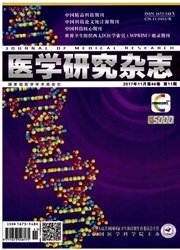

 中文摘要:
中文摘要:
目的探讨糖尿病合并高血压患者血糖血压水平与动脉硬化的关系。方法以北京某农村社区40岁及以上糖尿病合并高血压患者为研究对象,对患者进行问卷调查、体格检查、肱踝脉搏波传导速度(baPWV)检测和血样检测。根据患者糖化血红蛋白(HbAlc)、收缩压(SBP)及舒张压(DBP)水平进行分组,采用Logistic回归模型分析血糖血压水平与动脉硬化的关系。结果共纳入1214例患者,其中动脉硬化异常(baPWV≥1700cm/s)有637人,占52.47%。相关性分析显示baPWV与HbAlc(rs=0.174,P=0.000)、SBP(rs=0.481,P=0.000)及DBP(rs=0.167,P=0.000)均呈正相关。Logistic回归分析显示,调整其他危险因素后,HbAlc和SBP每增加1个四分位数间距动脉硬化异常风险分别为1.41倍(95%CI:1.16~1.70)和3.71倍(95%CI:2.80~4.91)。结论糖尿病合并高血压患者baPWV与HbAlc及SBP显著相关,同时控制血糖和血压可能有利于降低动脉硬化异常发生风险。
 英文摘要:
英文摘要:
Objective To investigate the relationship between arterial stiffness and blood glucose or blood pressure in community pa- tients with diabetes mellitus and hypertension. Methods Diabetic patients with hypertension aged 40 or above were enrolled from rural communities of Beijing. Every patient completed a standardized questionnaire and underwent physical examinations, braehial - ankle pulse wave velocity (baPWV) measurements, blood tests. Patients were divided into groups according to the level of glycated hemoglobin (HbAle) , systolic blood pressure (SBP) and diastolic blood pressure (DBP). Analyses were performed by using multiple logistic regres- sion model to explore the relationship between baPWV and blood glucose/blood pressure. Results Among 1214 patients enrolled, the detection rate of arterial stiffness (baPWV〉 1700cm/s) was 52.47%. Correlation analysis showed baPWV was positively associated with HbAle (r =0.174, P=0.000), SBP (r =0.481, P=0.000) and DBP (r =0.167 P=0.000). Aftermultivariable adjustment, an increase of one IQR (from 25th to the 75th percentile) in the HbA1 c and SBP was associated with greater risk of arterial stiffness [ HbA1 c ( an increase of 2% ) : OR=1.41 (95% CI: 1.16-1.70); SBP (an increase of 23mmHg): OR=3.71 (95% CI: 2.80-4.91)]. Conclusion The blood glucose/blood pressure was associated with baPWV among diabetic patients with hypertension. Combined efforts to improve both blood pressure and glycemie control may help to reduce the risk of arterial stiffness.
 同期刊论文项目
同期刊论文项目
 同项目期刊论文
同项目期刊论文
 Prevalence of cardiovascular disease and risk factors in a rural district of Beijing, China: a popul
Prevalence of cardiovascular disease and risk factors in a rural district of Beijing, China: a popul Neighborhood socioeconomic status and the prevalence of stroke and coronary heart disease in rural C
Neighborhood socioeconomic status and the prevalence of stroke and coronary heart disease in rural C 期刊信息
期刊信息
